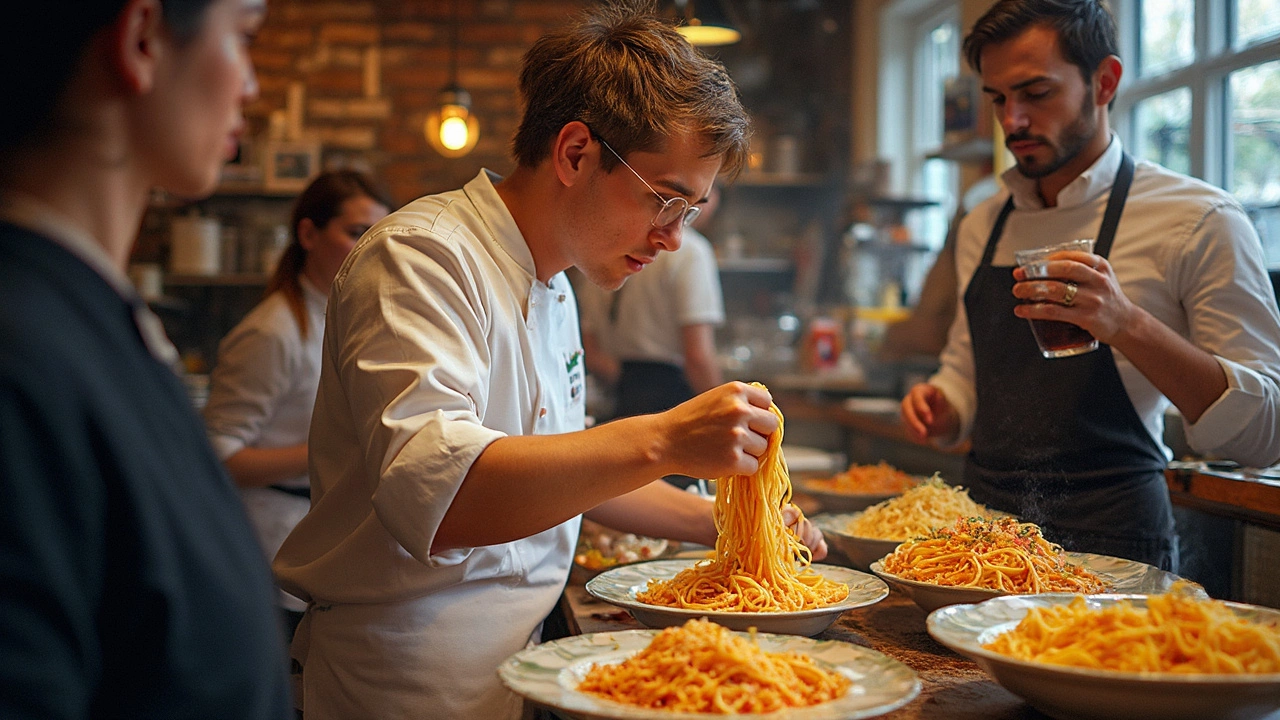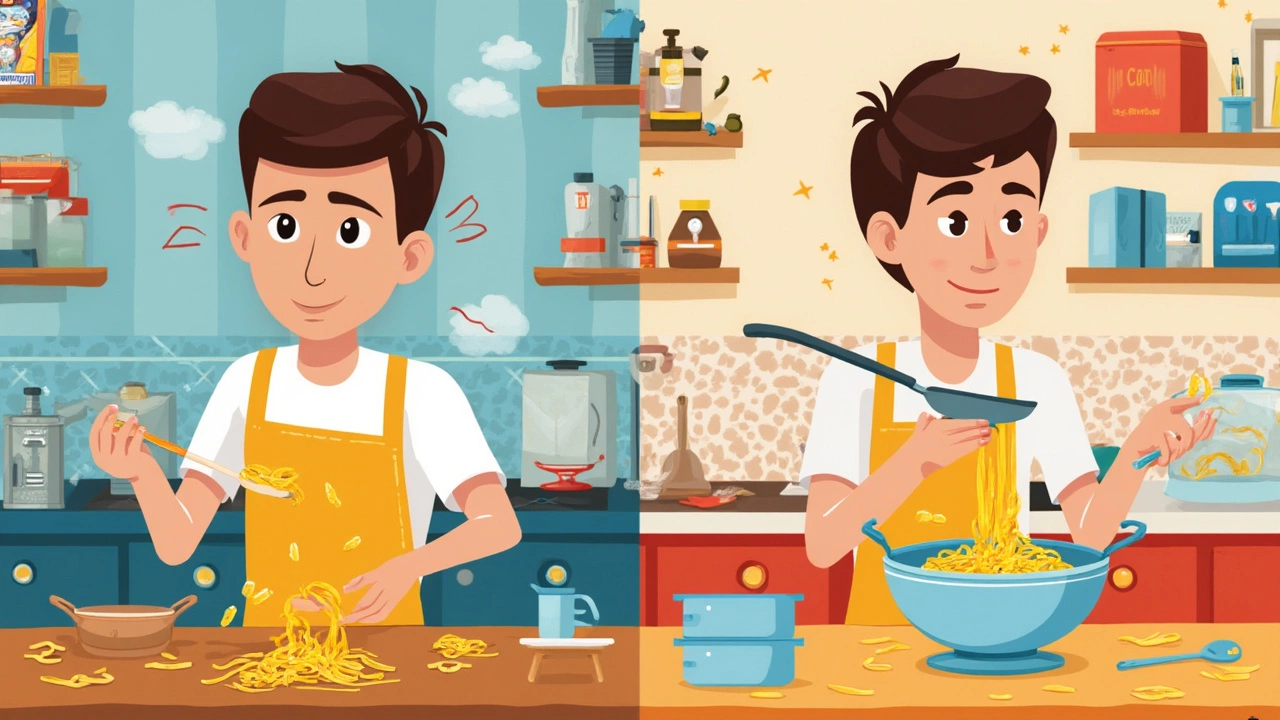Ever heard someone say pasta is just water, salt, and pasta? It’s not wrong, but they’re missing the secret that separates boring noodles from your dream spaghetti: the 10 100 1000 rule. No complicated math here—it’s just 10 grams of salt, 100 grams of dried pasta, and 1000 milliliters (1 liter) of water. That’s it. This ratio is standard in Italian kitchens, and there’s a reason chefs stick to it.
Most home cooks don’t measure, they just eyeball the salt and toss the pasta in. That’s often why the noodles turn out bland or sticky. With the 10 100 1000 rule, your pasta comes out perfectly seasoned, with the right bite and zero stodge.
You don’t need fancy tools. All you need is a kitchen scale and a measuring jug. Get this rule down, and you’ll instantly level up your pasta game. Ready to find out why it works and how to nail it yourself?
- What Does 10 100 1000 Mean?
- Why the Ratio Matters
- How to Use It at Home
- Common Mistakes (and How to Fix Them)
- Tweaks and Variations for Different Dishes
What Does 10 100 1000 Mean?
This rule is super simple. For every 100 grams of dried pasta you want to cook, use 1000 ml (1 liter) of water and 10 grams of salt. That’s all there is to it.
Here’s what each part means:
- 10 grams salt—This seems like a lot, but most of it stays in the water. It makes the pasta properly seasoned. You won’t get salty noodles—just flavor.
- 100 grams dried pasta—A standard serving for one person. Need more? Just multiply the amounts to keep the proportions right.
- 1000 ml water—This is enough water to let the pasta move freely, so it doesn’t stick together or cook unevenly.
Still worried about measuring? Here’s a quick reference:
| Pasta | Water | Salt |
|---|---|---|
| 100g | 1000ml | 10g |
| 200g | 2000ml | 20g |
| 500g | 5000ml (5L) | 50g |
For a family dinner, grab a big pot. If you don’t use enough water, the pasta releases extra starch, turning the pot cloudy and causing everything to clump together. That extra water dilutes the starch so your noodles end up with a perfect texture—smooth, with a little bite. The 10 100 1000 pasta rule helps you avoid mushy or bland results, and you can actually taste the difference. Restaurants rely on this because it’s that effective.
Why the Ratio Matters
The 10 100 1000 rule is way more than a chef's trick. It's a game-changer for how pasta turns out, whether you’re making a simple bowl of penne or prepping a fancy lasagna. This ratio keeps things balanced every time you cook.
First, let's talk about salt. Using the right amount – 10 grams per liter of water – means the pasta absorbs flavor while boiling. Too little? Your noodles taste flat even with loads of sauce. Too much? You'll feel like you just ate seawater. And when you get it just right, the pasta carries a gentle savory taste all on its own.
Moving on to water: 1 liter for every 100 grams of pasta gives the noodles enough space to move. Good water coverage helps prevent stuff like clumping and uneven cooking. Too little water means sticky, gummy pasta nobody wants to eat. Too much water? You waste energy and time for no good reason.
Here's a quick look at how the ratio stacks up to common mistakes:
| Setting | Salt | Pasta | Water | Common Result |
|---|---|---|---|---|
| Classic 10 100 1000 Rule | 10g | 100g | 1000ml | Perfectly seasoned, loose pasta |
| Typical Home Guess | 3-5g | 100g | 600ml | Bland, sticky pasta |
| Over-Salted | 20g | 100g | 1000ml | Overpowering salty noodles |
The 10 100 1000 pasta rule actually makes things easier. No more guessing, no more wondering why your pasta doesn't taste like what you get from your favorite Italian spot. Studies from Italian culinary schools even back this up: standardizing the amount of water and salt helps every pasta shape hold its texture and absorb sauce better.
- Better flavor—each noodle is seasoned inside and out.
- No wastage—just the amount of water you need for rolling boils and easy draining.
- Consistent results—cook once or a hundred times, and the result is the same.
So, the next time you boil pasta, remember that this rule is the backbone of consistency. Restaurant-quality noodles aren’t about expensive brands but getting the basics right with this ratio.

How to Use It at Home
Getting the 10 100 1000 ratio right feels almost too easy, but it works like magic. For every 100 grams of pasta (that’s about a hearty serving for one person), you're going to need 1 liter of water and exactly 10 grams of salt. Most home cooks skip the scale and end up with water that tastes like nothing. Shy salt means dull pasta—there's no drama here, just science.
First, measure your pasta. If you don’t have a scale, 100 grams is roughly a big handful or a full cup of most dried shapes. Next, grab your measuring jug—pour in a full liter of water for each 100 grams of pasta you’re cooking. Last, weigh out 10 grams of salt. That's about two level teaspoons, but using a scale is spot-on.
Bring the water to a rolling boil before you add the salt. When you drop the pasta in, it should swim around easily—crowding makes noodles gluey. Stir the pasta right after you add it so it won’t stick. Here’s a quick list if you want to keep things sharp:
- Weigh out 100 grams of dry pasta per person.
- Pour 1 liter of cold water into a big pot for every 100 grams.
- Weigh 10 grams of salt and toss it into the boiling water.
- Wait for the water to boil again, then add pasta.
- Stir well, cook until al dente, then drain (but save a splash of water for your sauce—it helps the sauce stick).
Wonder if this matters? According to food scientist Harold McGee,
"Properly salted water is essential—it’s going to give your pasta almost all its flavor before you ever add a sauce."That’s how restaurants get their pasta to taste so good, even with just olive oil and parmesan.
Here’s how the numbers stack up in real life:
| Pasta (g) | Water (L) | Salt (g) |
|---|---|---|
| 100 | 1 | 10 |
| 200 | 2 | 20 |
| 300 | 3 | 30 |
| 500 | 5 | 50 |
The 10 100 1000 pasta rule isn’t just some chef myth. Chefs use it because it actually works—and it’s just as handy at home. If you’re making a big batch, scale the numbers up evenly. Now your pasta will turn out better every single time, not just by chance.
Common Mistakes (and How to Fix Them)
Plenty of people mess up their pasta by missing a key part of the 10 100 1000 pasta rule. Even chefs slip up now and then. Here are the classic mistakes and what you can actually do about them:
- Not enough salt in the water. If your pasta tastes flat, odds are you didn’t add those 10 grams per liter. Most folks just throw in a pinch. Don’t be shy—good pasta water should taste a little like seawater. Keep your scale handy, especially until you get a feel for the right amount.
- Using too little water. Pasta needs space to move, or it sticks together and cooks unevenly. Skimping on water makes a gluey mess. Stick with 1 liter for every 100 grams of pasta. A big pot is always better.
- Overcrowding the pot. Don’t cram in more pasta than your water can handle. If you need to cook more, boil separate batches. You want rolling water, not a cramped soak.
- Forgetting to stir early on. Pasta clumps if you walk away right after adding it. Just give it a few stirs in the first two minutes and you’re golden.
- Draining away all the pasta water. Save a mug of that salty, starchy water before draining. That stuff is liquid gold for finishing sauces—it makes everything cling better and taste smoother.
- Guessing the timing. Set a timer! Pasta can swing from perfect to soggy in just a minute. Start checking about two minutes before the package says it’s ready.
Here’s a quick comparison on common blunders and the fix:
| Mistake | What Happens | How to Fix It |
|---|---|---|
| Too little salt | Bland pasta | Weigh out 10g salt per 1L water next time |
| Not enough water | Sticky, uneven noodles | Stick to 1L per 100g pasta ratio |
| Skipping water stir | Pasta clumps | Stir in first 1-2 minutes |
| Dumping all pasta water | Dry sauce that won’t stick | Save some water for sauce mixing |
Nail the ratio and these basics, and your pasta will be on par with the pros every single time.

Tweaks and Variations for Different Dishes
The 10 100 1000 rule isn't just a one-size-fits-all deal. Different pasta shapes, sauces, or dietary needs sometimes call for a tweak or two. Let’s run through some practical ways to adapt the rule to fit what you’re cooking up.
10 100 1000 pasta rule is most reliable for classics like spaghetti, penne, or fusilli, but what about fresh pasta? Fresh pasta cooks faster and soaks up water differently. Many chefs drop the salt to 7 grams per 1 liter of water because the dough itself often contains salt and eggs.
If you’re making a big batch or want to feed a crew, just scale the rule up to keep the ratio intact. Got 300 grams of pasta? That’s 30 grams salt and 3 liters water. No need to overthink it.
Some sauces need more punch. For richer, cream-based sauces like Alfredo, try cooking pasta with a little less salt (8 grams per liter) so the flavors stay balanced. For seafood pasta, especially if you’re tossing in clams or mussels, you’ll want to cut the salt in the water by half so things don’t get too briny.
"Salt is the single most important ingredient in pasta water. But remember, not every dish should taste like the sea." — Massimo Bottura, Osteria Francescana chef (interview, The Guardian)
If you’re short on water—like when camper or dorm cooking—use just enough to cover the pasta and stir often. The starch will be more concentrated, which makes for a thicker, almost restaurant-style sauce. But definitely pull back the salt to avoid the pasta getting too salty.
Gluten-free pasta behaves a bit different, too. Most brands recommend a larger water-to-pasta ratio, closer to 1.5 liters per 100 grams. This stops the pasta from sticking and getting mushy. Salt, though, stays about the same—just taste and tweak since gluten-free noodles all taste a bit different.
| Pasta Type | Water (ml) | Salt (g) | Tips |
|---|---|---|---|
| Dried pasta | 1000 | 10 | Classic ratio |
| Fresh pasta | 1000 | 7 | Reduce salt |
| Seafood pasta | 1000 | 5 | Halve salt |
| Creamy sauces | 1000 | 8 | Less salt, balance sauce |
| Gluten-free | 1500 | 10 | Extra water, stir well |
- Always add salt after the water comes to a boil. It dissolves faster, spreads more evenly, and won’t pit your pot.
- For small batch cooking, keep the ratio but use a kitchen scale for accuracy.
- Don’t forget to save a cup of starchy pasta water—a pro move for thickening any sauce.
The golden rule? Taste and adjust. This ratio is a killer starting point, but great pasta always leaves room for your own spin.

